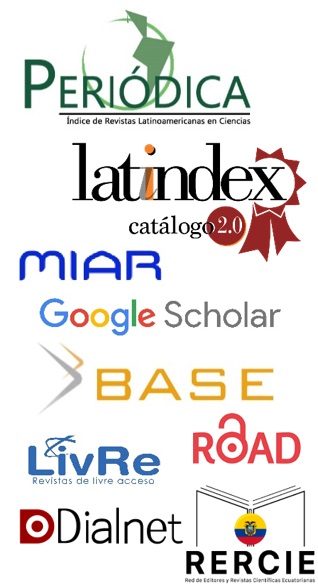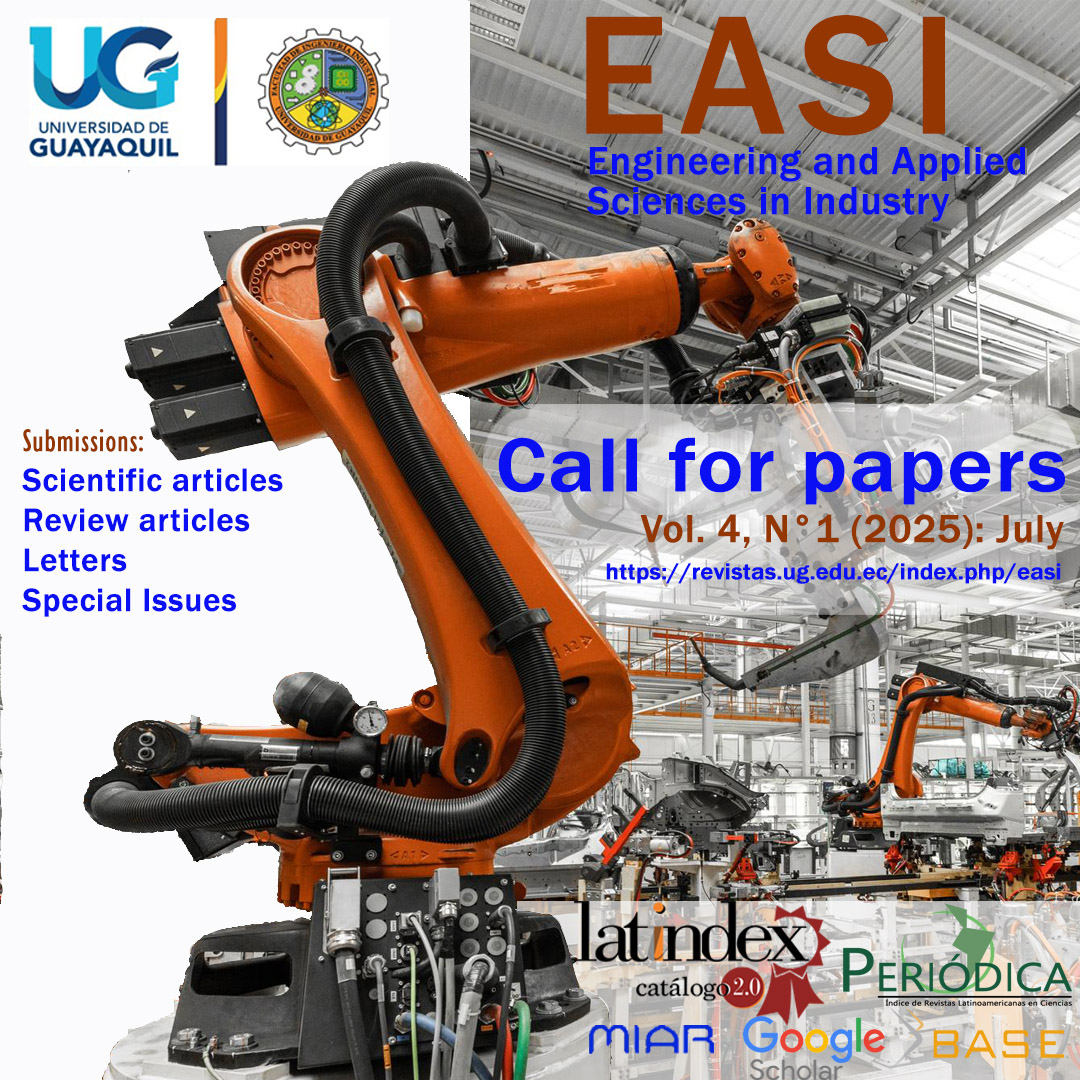Literature review of waste management strategies in industry
DOI:
https://doi.org/10.53591/easi.v2i1.2188Keywords:
waste, management, circular economy, environmentalAbstract
Waste management strategies to provide sustainable solutions in industry processes to accomplish current regulations are crucial in industrial engineering. The general objective of this study was to summarize waste management practices in industrial plants by applying a systematic mapping of literature in citation databases (Redalyc, Scopus, and Web of Science). First, a scoping review led the process to determine current waste management practices in industrial plants. The analysis of hazardous waste management practices includes minimization, recycling, and reuse. The general approach is focused on the facilities to promote safe waste storage, transport, and final disposal.
References
Arockiam JeyaSundar, P. G. S., Ali, A., Guo, di, & Zhang, Z. (2020). Waste treatment approaches for environmental sustainability. In Microorganisms for Sustainable Environment and Health. INC. https://doi.org/10.1016/B978-0-12-819001-2.00006-1
Awuchi, C. G., Twinomuhwezi, H., Awuchi, C. G., Victory, I. S., & Amagwula, I. O. (2020). Industrial Waste Management, Treatment, and Health Issues: Wastewater, Solid, and Electronic Wastes. European Academic Research, 8(2), 1081–1119. https://euacademic.org/UploadArticle/4383.pdf
Barton, C. C., & Ainerua, M. O. (2020). Environmental toxicology: hazardous waste. In Information Resources in Toxicology, Volume 1: Background, Resources, and Tools. INC. https://doi.org/10.1016/B978-0-12-813724-6.00028-1
Castro, P. J., Aráujo, J. M. M., Martinho, G., & Pereiro, A. B. (2021). Waste management strategies to mitigate the effects of fluorinated greenhouse gases on climate change. Applied Sciences (Switzerland), 11(10). https://doi.org/10.3390/app11104367
Cheng, Y.-L., Lee, C.-Y., Huang, Y.-L., Buckner, C. A., Lafrenie, R. M., Dénommée, J. A., Caswell, J. M., Want, D. A., Gan, G. G., Leong, Y. C., Bee, P. C., Chin, E., Teh, A. K. H., Picco, S., Villegas, L., Tonelli, F., Merlo, M., Rigau, J., Diaz, D., … Mathijssen, R. H. J. (2016). We are IntechOpen , the world ’ s leading publisher of Open Access books Built by scientists , for scientists TOP 1 %. Intech, 11(tourism), 13. https://www.intechopen.com/books/advanced-biometric-technologies/liveness-detection-in-biometrics
Chugchilan Cuichan, J. (2020). UNIVERSIDAD CENTRAL DEL ECUADOR FACULTAD DE FILOSOFÍA , LETRAS Y CIENCIAS DE LA CARRERA DE MECÁNICA AUTOMOTRIZ Manejo de residuos sólidos y líquidos en el centro de mantenimiento automotriz “ Plaza de Quito FAE ” para evitar la contaminación ambiental Tra. 80.
Consejo Nacional de Competencias (CNC). (2019). Informe sobre mapeo de actores generadores de información a nivel territorial e identificación de fuentes de información de la competencia de desechos sólidos. Paper Knowledge . Toward a Media History of Documents, 1(2), 1–64. http://www2.competencias.gob.ec/wp-content/uploads/2021/03/03-Manejo-desechos-solidos-2.pdf
Cortez Suarez, L. A., Petroche Torres, D. J., Camba Ramirez, W. E., & Mariscal Santi, W. E. (2022). Comportamiento compostable y biodegradable de bioplásticos producidos con desechos agrícolas. Reciamuc, 6(3), 546–555. https://doi.org/10.26820/reciamuc/6.(3).julio.2022.546-555
Dehghani, M. H., Omrani, G. A., & Karri, R. R. (2021). Solid Waste—Sources, Toxicity, and Their Consequences to Human Health. Soft Computing Techniques in Solid Waste and Wastewater Management, January, 205–213. https://doi.org/10.1016/B978-0-12-824463-0.00013-6
Diseño y desarrollo de estrategias para la gestión de residuos reciclables en la zona de influencia del Centro Universitario Puerto de Mar del Plata. (2021).
Ferronato, N., & Torretta, V. (2019). Waste mismanagement in developing countries: A review of global issues. International Journal of Environmental Research and Public Health, 16(6). https://doi.org/10.3390/ijerph16061060
Gemar, G., Soler, I. P., & Sánchez-Teba, E. M. (2021). Waste management: Valorisation is the way. Foods, 10(10). https://doi.org/10.3390/FOODS10102373
Godswill, A. C. (2017). Industrial Waste Management: Brief survey and advice to cottage, small and medium scale industries in Uganda Industrial Waste Management: Brief survey and advice to cottage, Small and Medium Scale Industries in Uganda Department of Biological and Envi. International Journal of Advanced Academic Research | Sciences, Technology & Engineering, 3(1), 26–30.
Godswill, A. C., Gospel, A. C., Otuosorochi, A. I., & Somtochukwu, I. V. (2020). Industrial And Community Waste Management: Global Perspective. American Journal of Physical Sciences, 1(1), 1–16. https://doi.org/10.47604/ajps.1043
Gu, J., Liu, X., & Zhang, Z. (2023). Road base materials prepared by multi-industrial solid wastes in China: A review. Construction and Building Materials, 373(February), 130860. https://doi.org/10.1016/j.conbuildmat.2023.130860
Hole, G., & Hole, A. S. (2019). Recycling as the way to greener production: A mini review. Journal of Cleaner Production, 212, 910–915. https://doi.org/10.1016/j.jclepro.2018.12.080
Ibrahim, M. H., El-Naas, M. H., & Banerjee, A. (2022). Treatment of petroleum industry wastewater: current practices and perspectives. Petroleum Industry Wastewater: Advanced and Sustainable Treatment Methods, 1–6. https://doi.org/10.1016/B978-0-323-85884-7.00015-1
Jiménez González, T., & Carrasco, A. M. (2021). Trabajo Fin de Grado Ingeniería Química Generación de lixiviados en vertederos.
Li, X., Chertow, M., Guo, S., Johnson, E., & Jiang, D. (2020). Estimating non-hazardous industrial waste generation by sector, location, and year in the United States: A methodological framework and case example of spent foundry sand. Waste Management, 118, 563–572. https://doi.org/10.1016/j.wasman.2020.08.056
Mandpe, A., Paliya, S., Gedam, V. V., Patel, S., Tyagi, L., & Kumar, S. (2023). Circular economy approach for sustainable solid waste management: A developing economy perspective. Waste Management and Research, 41(3), 499–511. https://doi.org/10.1177/0734242X221126718
Martínez Prats, G., Tosca Vidal, C. M., & Juárez Domínguez, A. A. (2019). Impuestos ambientales sobre los desechos sólidos en Tabasco: en pro del medio ambiente. Telos, 21(2), 333–346. https://doi.org/10.36390/telos212.05
Menbere, M. P. (2019). Industrial Wastes and Their Management Challenges in Ethiopia. Chemistry and Materials Research, 1–6. https://doi.org/10.7176/cmr/11-8-01
Morcillo, M. (2022). El futuro de la energía nuclear y su papel en la transición energética. Técnica Industrial, ISSN 0040-1838, No 333, 2022, Págs. 4-8, 333, 4–8. https://dialnet.unirioja.es/servlet/articulo?codigo=8745490&info=resumen&idioma=SPA%0Ahttps://dialnet.unirioja.es/servlet/articulo?codigo=8745490
Nai, C., Tang, M., Liu, Y., Xu, Y., Dong, L., Liu, J., & Huang, Q. (2021). Potentially contamination and health risk to shallow groundwater caused by closed industrial solid waste landfills: Site reclamation evaluation strategies. Journal of Cleaner Production, 286. https://doi.org/10.1016/j.jclepro.2020.125402
Negrete-Cardoso, M., Rosano-Ortega, G., Álvarez-Aros, E. L., Tavera-Cortés, M. E., Vega-Lebrún, C. A., & Sánchez-Ruíz, F. J. (2022). Circular economy strategy and waste management: a bibliometric analysis in its contribution to sustainable development, toward a post-COVID-19 era. Environmental Science and Pollution Research, 29(41), 61729–61746. https://doi.org/10.1007/s11356-022-18703-3
Njoku, P. O., Edokpayi, J. N., & Odiyo, J. O. (2019). Health and environmental risks of residents living close to a landfill: A case study of thohoyandou landfill, Limpopo province, South Africa. International Journal of Environmental Research and Public Health, 16(12), 10–12. https://doi.org/10.3390/ijerph16122125
Olivares, N., Gómez, S., Contreras, J., & Hernández, G. (2018). Propuesta De Diseño De Una Planta Industrial Para El Tratamiento De Los Residuos Sólidos Urbanos Para El Municipio De Arandas, Jalisco. Ra Ximhai, 14, 2.
Organización de las Naciones Unidas para el Desarrollo Industrial (ONUDI). (2018). Informe sobre el Desarrollo Industrial 2018. Demanda de manufacturas: Impulsando el desarrollo industrial inclusivo y sostenible. Resumen. 48. https://www.unido.org/sites/default/files/files/2017-11/IDR2018_OVERVIEW_SPANISH.pdf
Román Brito-Carvajal, J. I. (2021). Sistema de producción industrial: sostenibilidad y productividad Industrial production system: sustainability and productivity Sistema de produção industrial: sustentabilidade e produtividade. 6(9), 2521–2531. https://doi.org/10.23857/pc.v6i9.3193
Salmenperä, H., Pitkänen, K., Kautto, P., & Saikku, L. (2021). Critical factors for enhancing the circular economy in waste management. Journal of Cleaner Production, 280. https://doi.org/10.1016/j.jclepro.2020.124339
Scharff, H., & Kok, B. (2007). The role of sustainable landfill in future waste management systems. Proceedings Sardinia, January 1996, 1–8. http://www.iswa.org/uploads/tx_iswaknowledgebase/618166_Paper.pdf%5Cnpapers3://publication/uuid/D1800ACC-876D-4E26-89E3-A789260C8AF2
Sharkawi, A. E. D. (2015). Recycling Local Industrial Wastes for Production of Green Construction Materials. Journal of Engineering Research, 1(2015), 26–39. https://doi.org/10.21608/erjeng.2015.128166
Siles-Castellano, A. B., López, M. J., López-González, J. A., Suárez-Estrella, F., Jurado, M. M., Estrella-González, M. J., & Moreno, J. (2020). Comparative analysis of phytotoxicity and compost quality in industrial composting facilities processing different organic wastes. Journal of Cleaner Production, 252. https://doi.org/10.1016/j.jclepro.2019.119820
Sivaram, N. M., & Barik, D. (2018). Toxic waste from leather industries. In Energy from Toxic Organic Waste for Heat and Power Generation. Elsevier Ltd. https://doi.org/10.1016/B978-0-08-102528-4.00005-5
Sundramurthy, V. P., Nithya, T. G., Masi, C., Gomadurai, C., & M. Abda, E. (2021). Recent advances and prospects for industrial waste management and product recovery for environmental appliances. Physical Sciences Reviews, January 2022. https://doi.org/10.1515/psr-2021-0063
Tait, P. W., Brew, J., Che, A., Costanzo, A., Danyluk, A., Davis, M., Khalaf, A., McMahon, K., Watson, A., Rowcliff, K., & Bowles, D. (2020). The health impacts of waste incineration: a systematic review. Australian and New Zealand Journal of Public Health, 44(1), 40–48. https://doi.org/10.1111/1753-6405.12939
UNEP/OCHA. (2011). Disaster Waste Management Guidelines.United Nations Office for the coordination of humanitarian affairs, emergency preparedness section UNEP/OCHA, 2011.
Valdés, A., López, E., & Alonso, A. (2019). Gestión de residuos industriales y sostenibilidad. Necesidad de un enfoque de economía ecológica. Universidad y Sociedad., 4, 424–435. https://orcid.org/0000-0002-8503-3025%0Ahttp://scielo.sld.cu/scielo.php?pid=S2218-36202019000400424&script=sci_arttext&tlng=en
Vallero, D. A., & Shulman, V. (2019). Introduction to Waste Management. In Waste: A Handbook for Management (Issue March). https://doi.org/10.1016/B978-0-12-815060-3.00001-3
Willskytt, S., & Brambila-Macias, S. A. (2020). Design guidelines developed from environmental assessments: A design tool for resource-efficient products. Sustainability (Switzerland), 12(12). https://doi.org/10.3390/SU12124953
Published
How to Cite
Issue
Section
License
Copyright (c) 2023 Anderson Suquisupa Villacis, Milena Morales Núñez, Aldo Parrales León, Marianela Morante-Galarza

This work is licensed under a Creative Commons Attribution-NonCommercial-NoDerivatives 4.0 International License.
Contributions published in the EASI journal follow the open access license CC BY-NC-ND 4.0 (Creative Commons Attribution-NonCommercial-NoDerivs 4.0). This license empowers you as an author and ensures wide dissemination of your research while still protecting your rights.
For authors:
- Authors retain copyrights without restrictions according to CC BY-NC-ND 4.0 license.
- The journal obtains a license to publish the first original manuscript.
For readers/users:
Free access and distribution: Anyone can access, download, copy, print, and share the published article freely according to the license CC BY-NC-ND 4.0 terms.
Attribution required: If any third party use the published material, they must give credit to the creator by providing the name, article title, and journal name, ensuring the intellectual property of the author(s), and helping to build the scholarly reputation.
Non-commercial use: only noncommercial use of the published work is permitted. Noncommercial means not primarily intended for or directed towards commercial advantage or monetary compensation by any third party.
No modifications allowed: The content of the published article cannot be changed, remixed, or rebuilt upon the author’s work. This ensures the integrity and accuracy of the research findings.



